Classification and Application of Digital Technologies in Landscape Heritage Protection
Abstract
1. Introduction
2. Methodology
- Literature search. The WoS database and CNKI database were searched with the keywords “digital landscape heritage” and “Digital Heritage protection”.
- Literature processing and screening. By screening the search results of the database and eliminating papers that were not consistent with the research theme of this paper, we obtained 429 papers in total. Among them, 281 papers were obtained from the CNKI database, and 148 papers were obtained from the WoS database.
- Data analysis. Firstly, the software Citespace was used to conduct a quantitative analysis of keywords co-occurrence and keyword clustering of the literature, and then we drew the related knowledge graph. Secondly, the popular digital technologies in the field of landscape architecture heritage protection were classified using Excel, and the digital methods and applications for different heritage protection objects were summarized. Thirdly, according to the time sequence analysis of keyword co-occurrence clustering and the timeline diagram of keywords, we analyzed the hot topics and digital technologies of landscape architecture heritage protection over the last 10 years. Eventually, through the analysis of the keywords emergence of digital heritage protection, combined with the relevant social backgrounds and policy theories, the application trend and development mechanism of digital technology of landscape architecture heritage protection for different heritage protection objects were analyzed and summarized.
3. Results
3.1. Collection and Acquisition Technology of Heritage Data
3.1.1. Topography
3.1.2. Rockery
3.1.3. Architecture
3.1.4. Other Types
3.2. Storage and Management Technology of Heritage Data
3.2.1. Storage
3.2.2. Management
3.3. Dissemination and Sharing Technology of Heritage Information
4. Discussion
4.1. Application of Digital Technology in Landscape Architecture Heritage Protection
4.1.1. Repair Recovery
4.1.2. Risk Monitoring
4.2. Research Hotspots and Trends of Digital Technology in Landscape Architecture Heritage Protection
- (a)
- The stage of data precision. During the period of 2012–2014, owing to policy support, such as “Sponge City” and the “National Park” theory, etc., many ancient buildings, tombs, and some natural features in digital measurement appeared, which compared with the previous traditional measurement method, was more scientific and accurate. Furthermore, they combined GIS, GPS, and other information systems to create a database, which made the legacy data more accurate. In order to match the political intentions of “Updated and Sustainable Cultural Heritage Management”, Trier described a new method for the automatic detection of pit structures in airborne laser scanning data collected with at least five emitted pulses per square meter [82]; Gruetzner used an octocopter equipped with a high-resolution range finder camera to gather information on the topographical setting and morphometry of the rampart [44].
- (b)
- The stage of information systematization. From 2015 to 2017, under the guidance of “Double Urban Repairs” (“Ecological Restoration and City Betterment”), “Rural revitalization”, etc., heritage protection of traditional settlements and ancient villages became the focus of digital heritage research. The concept of “Resilience Landscape” enabled scholars to analyze the risks caused by geological disasters and extreme weather, allowing them to conduct virtual displays through data simulation to carry out preventive protection of heritage and form a relatively complete digital protection system of “collection, restoration and prevention”. Towards the development of The Copernicus Program in support of cultural heritage preservation and management, there is increasing exploitation of Interferometric Synthetic Aperture Radar (InSAR) methods to assess geohazards affecting cultural heritage [5]. As a result, Gupta conceptualized a framework for incorporating spatial and non-spatial knowledge of archaeological sites into a National Archaeological Database [83].
- (c)
- The stage of smart management. From 2018 to 2021, “Smart City” promoted the wisdom development of landscape architecture. Liang proposed that social media are one of the most important platforms to promote the public participation process of urban heritage conservation in the context of rapid urbanization [84]. Inclusion is a key value in the implementation of the “New Urban Agenda” and the achievement of sustainable development goals; Ginzarly proposed a methodology for the analysis of viewpoints location-view scenes-tags data for photos posted on Flickr to provide insights into all facets of the perceived landscape character that identifies people-centered heritage at the city level [58]. Digital protection is not just about the protection of heritage entities, it also pays attention to cultural protection, which through the way of virtual reality, artificial intelligence reproduces collective memory and personal emotion. As a result, the quality of information management and the traditional way of heritage protection were improved. The meaning of cultural heritage has been extended to the concept of “Cultural Landscape”. Demetrescu presented a new perspective for the documentation and representation of cultural landscape that includes not only the structures of the city but also the areas that have not been excavated yet, including the surrounding natural environment [60].
5. Conclusions
- (a)
- Collection and acquisition technology can be used to analyze the characteristics of the remaining elements of landscape architecture heritage, such as rockeries, architectural sketches, and buildings in precise digital models.
- (b)
- Designing the corresponding data system and platform through storage and management technology can repair and store the data in the database to manage the data according to different situations.
- (c)
- Dissemination and sharing technology can simulate the heritage environment, as well as disseminate and share heritage information to the public using new interaction and experience methods.
Notes
- Historic Urban Landscape: “Historic Urban Landscape” is a suitable name for the natural and cultural and material and immaterial historical context and value in all cities. It is not solely suitable for “Historic town”, “Historic city”, and other special protection categories under the city.
- Vincent. M.L scholars in the Heritage and Archaeology in the Digital Age: Acquisition, Curation, and Dissemination of Spatial Cultural To be specific, Heritage Data divide the digital technologies in the protection of cultural heritage into acquisition, curation, and dissemination, which are drawn from the ref. [24].
- Photogrammetry: Cameras and other equipment obtain images of the object and describe the measured results in graphics, images, or models.
- Structure from motion: A technique in which camera parameters are obtained by analyzing image sequences when 3D reconstruction is performed.
- Digital twin: Using physical models and other data, complete mapping in virtual space reflects the corresponding physical equipment.
- Sparse model: Removes redundant variables, retain explanatory variables related to response variables, simplify the model, and retain the most important information in the data set.
- Sparse autoencoder: By calculating the error between the output and input of the autoencoder, the parameters of the autoencoder are constantly adjusted to train the model.
- Compressed sensing: A technique for finding sparse solutions of underdetermined linear systems.
- Synthetic aperture radar (SAR): A high-resolution imaging radar which can obtain high-resolution radar images similar to optical photography in meteorological conditions with very low visibility.
- Multi-temporal: Reflects the characteristics of a group of remote sensing images in time series.
Author Contributions
Funding
Data Availability Statement
Conflicts of Interest
References
- Frodella, W.; Elashvili, M.; Spizzichino, D.; Gigli, G.; Nadaraia, A.; Kirkitadze, G.; Adikashvili, L.; Margottini, C.; Antidze, N.; Casagli, N. Applying close range non-destructive techniques for the detection of conservation problems in rock-carved cultural heritage sites. Remote Sens. 2021, 13, 1040. [Google Scholar] [CrossRef]
- Cai, L. Conceptual pedigree and process diagram of digital planning and design of landscape architecture. Landsc. Archit. 2013, 1, 48–57. [Google Scholar]
- Machete, R.; Silva, J.R.; Bento, R.; Falcao, A.P.; Goncalves, A.B.; de Carvalho, J.M.L.; Silva, D.V. Information transfer between two heritage BIMs for reconstruction support and facility management: The case study of the Chalet of the Countess of Edla, Sintra, Portugal. J. Cult. Herit. 2021, 49, 94–105. [Google Scholar] [CrossRef]
- Nicu, I.C. Is digital shoreline analysis system “fit” for gully erosion assessment? Catena 2021, 203, 105307. [Google Scholar] [CrossRef]
- Tapete, D.; Cigna, F. InSAR data for geohazard assessment in UNESCO World Heritage sites: State-of-the-art and perspectives in the Copernicus era. Int. J. Appl. Earth Obs. Geoinf. 2017, 63, 24–32. [Google Scholar] [CrossRef]
- Zhang, S.; Pang, B. Numerical simulation of landscape waterfall based on fluid dynamics theory. Water Supply Drain. 2014, 12, 120–123. [Google Scholar]
- Prieto, A.J. Fuzzy systems in the digital management of heritage timber buildings in South Chile. Build. Res. Inf. 2021, 49, 878–892. [Google Scholar] [CrossRef]
- Perko, D.; Hrvatin, M.; Ciglic, R. A Methodology for natural landscape typification of Slovenia. Acta Geogr. Slov. 2015, 55, 235–270. [Google Scholar] [CrossRef]
- Cheng, S.; Zhang, X.; Cheng, Y. Prospect of the application of digital landscape technology in the field of Chinese landscape architecture. Landsc. Archit. 2021, 28, 46–52. [Google Scholar]
- Academic Degrees Committee of the State Council. Demonstration Report on Adding Landscape Architecture as the First Level Discipline. Chin. Landsc. Archit. 2011, 27, 4–8. [Google Scholar]
- Han, F. World Heritage cultural landscape and its new international trends. Chin. Landsc. Archit. 2007, 11, 18–21. (In Chinese) [Google Scholar]
- Wu, D. On the protection of cultural landscape heritage and landscape culture. Chin. Landsc. Archit. 2011, 27, 1–3. [Google Scholar]
- Cao, X. Landscape architecture should play an important role in heritage protection. Landsc. Archit. 2012, 1, 154. [Google Scholar]
- Han, F. Cultural landscape in exploration. Chin. Landsc. Archit. 2012, 28, 5. [Google Scholar]
- Lin, G.; Xiao, L. Field and Evolution of Landscape architecture heritage protection. In Proceedings of the 2012 International Federation of Landscape Architects (IFLA) Asia-Pacific Regional Conference and 2012 Annual Conference of Chinese Society of Landscape Architecture, Shanghai, China, 22 October 2012; Volume I, pp. 90–94. [Google Scholar]
- Fadli, F.; AlSaeed, M. Digitizing vanishing architectural heritage; The design and development of Qatar historic buildings information modeling [Q-HBIM] platform. Sustainability 2019, 11, 2501. [Google Scholar] [CrossRef]
- Marra, A.; Gerbino, S.; Greco, A.; Fabbrocino, G. Combining Integrated Informative System and Historical Digital Twin for Maintenance and Preservation of Artistic Assets. Sensors 2021, 21, 5956. [Google Scholar] [CrossRef] [PubMed]
- Yang, C.; Han, F.; Liu, C. Research on spatial information recording and visualization of rural landscape heritage based on point cloud technology. Landsc. Archit. 2018, 25, 37–42. [Google Scholar]
- Yang, C.; Han, F. Digital heritage landscape: Research on Spatial Characteristics of large Rockery in Shanghai Yuyuan Garden based on 3D point cloud technology. Chin. Landsc. Archit. 2018, 34, 20–24. [Google Scholar]
- Zhang, B. Research on mountain management method of traditional Chinese garden promoted by three-dimensional digital technology. Anc. Landsc. Technol. 2010, 2, 36–38. [Google Scholar]
- Zhang, R.; Zhao, Y.; Kong, J.; Cheng, C.; Liu, X.; Zhang, C. Intelligent Recognitionand lts Sustainable Application forDecorative Openwork Windows of Traditional PrivateGardens in Suzhou China. Sustainability 2021, 13, 8439. [Google Scholar] [CrossRef]
- Deng, X.; Kim, I.T.; Shen, C. Research on Convolutional Neural Network-Based Virtual Reality Platform Framework for the Intangible Cultural Heritage Conservation of China Hainan Li Nationality: Boat-Shaped House as an Example. Math. Probl. Eng. 2021, 2021, 5538434. [Google Scholar] [CrossRef]
- Zhong, H.; Wang, L.; Zhang, H. The application of virtual reality technology in the digital preservation of cultural heritage. Comput. Sci. Inf. Syst. 2021, 18, 535–551. [Google Scholar] [CrossRef]
- Vincent, M.L.; Bendicho, V.M.L.M.; Ioannides, M.; Ioannides, M.; Levy, T.E. Heritage and Archaeology in the Digital Age: Acquisition, Curation, and Dissemination of Spatial Cultural Heritage Data; Springer International Publishing: Cham, Switzerland, 2017. [Google Scholar]
- Elassal, M. Geomorphological Heritage Attractions Proposed for Geotourism in Asir Mountains, Saudi Arabia. Geoheritage 2020, 12, 78. [Google Scholar] [CrossRef]
- Cucchiaro, S.; Fallu, D.J.; Zhang, H.; Walsh, K.; Van Oost, K.; Brown, A.G.; Tarolli, P. Multiplatform-SfM and TLS data fusion for monitoring agricultural terraces in complex topographic and landcover conditions. Remote Sens. 2020, 12, 1946. [Google Scholar] [CrossRef]
- Fu, H.; Fu, B.; Shi, P. An Improved Segmentation Method for Automatic Mapping of Cone Karst from Remote Sensing Data Based on DeepLab V3+ Model. Remote Sens. 2021, 13, 441. [Google Scholar] [CrossRef]
- Prus, B.; Wilkosz-Mamcarczyk, M.; Salata, T. Landmarks as Cultural Heritage Assets Affecting the Distribution of Settlements in Rural Areas—An Analysis Based on LIDAR DTM, Digital Photographs, and Historical Maps. Remote Sens. 2020, 12, 1778. [Google Scholar] [CrossRef]
- Cillis, G.; Statuto, D.; Picuno, P. Integrating remote-sensed and historical geodata to assess interactions between rural buildings and agroforestry land. J. Environ. Eng. Landsc. Manag. 2021, 29, 229–243. [Google Scholar] [CrossRef]
- Thuestad, A.E.; Risbøl, O.; Kleppe, J.I.; Barlindhaug, S.; Myrvoll, E.R. Archaeological Surveying of Subarctic and Arctic Landscapes: Comparing the Performance of Airborne Laser Scanning and Remote Sensing Image Data. Sustainability 2021, 13, 1917. [Google Scholar] [CrossRef]
- Cekada, M.T.; Radovan, D.; Lipus, B.; Mongus, D. Very Small Glaciers as Geoheritage: Combining a Spatio-Temporal Visualisation of Their Development and Related Effects of Climate Change. Geoheritage 2020, 12, 85. [Google Scholar] [CrossRef]
- Huilin, L. Research on 3D Digital Information of Suzhou Huanxiu Villa Garden; Nanjing Forestry University: Nanjing, China, 2018. [Google Scholar]
- Yu, M.Z.; Lin, X. Research on surveying and mapping methods of ponds and hills in classical gardens based on 3D laser scanning and close-range photogrammetry. Landsc. Archit. 2017, 2, 117–122. [Google Scholar]
- Moropoulou, A.; Zendri, E.; Ortiz, P.; Delegou, E.T.; Ntoutsi, I.; Balliana, E.; Becerra, J.; Ortiz, R. Scanning microscopy techniques as an assessment tool of materials and interventions for the protection of built cultural heritage. Scanning 2019, 2019, 5376214. [Google Scholar] [CrossRef] [PubMed]
- Oses, N.; Dornaika, F.; Moujahid, A. Image-based delineation and classification of built heritage masonry. Remote Sens. 2014, 6, 1863–1889. [Google Scholar] [CrossRef]
- Hou, X.; Cheng, B.; Yang, J. A quantitative study on the exterior wall texture of stone-built dwellings in traditional villages in China: A case study of the xisuo village in the Jiarong Tibetan area. J. Build. Eng. 2021, 42, 102357. [Google Scholar] [CrossRef]
- Liu, J. Component-driven pocedural modeling for ancient Chinese architecture of the Qing Dynasty. Int. J. Archit. Herit. 2018, 12, 280–307. [Google Scholar] [CrossRef]
- Zhu, X.; Chen, F.; Guo, H. Reconstruction of the Water Cultivation Paleoenvironment Dating Back to the Han and Tang Dynasties Surrounding the Yangguan Frontier Pass Using X-and L-Band SAR Data. Remote Sens. 2018, 10, 1536. [Google Scholar] [CrossRef]
- Bayarri, V.; Castillo, E.; Ripoll, S.; Sebastian, M.A. Improved application of hyperspectral analysis to rock art panels from El Castillo cave (Spain). Appl. Sci. 2021, 11, 1292. [Google Scholar] [CrossRef]
- Wang, N.; Wang, W.; Hu, W. Thangka Mural Line Drawing Based on Cross Dense Residual Architecture and Hard Pixel Balancing. IEEE Access 2021, 9, 48841–48850. [Google Scholar] [CrossRef]
- Ge, H.; Deng, S. Research on three-dimensional digital protection of Mausoleum stone carvings in Southern Dynasty. Urban Surv. 2014, 6, 14–16, 27. [Google Scholar]
- Yao, Y.; Wang, X.; Lu, L.; Liu, C.; Wu, Q.; Ren, H.; Yang, S.; Sun, R.; Luo, L.; Wu, K. Proportionated Distributions in Spatiotemporal Structure of the World Cultural Heritage Sites: Analysis and Countermeasures. Sustainability 2021, 13, 2148. [Google Scholar] [CrossRef]
- Martínez, S.; Ortiz, J.; Gil, M.L. Geometric documentation of historical pavements using automated digital photogrammetry and high-density reconstruction algorithms. J. Archaeol. Sci. 2015, 53, 1–11. [Google Scholar] [CrossRef]
- Grützner, C.; Bemmann, J.; Berking, J.; Frechen, M.; Klinger, R.; Klitzsch, N.; Linzen, S.; Mackens, S.; Oczipka, M.; Piezonka, H.; et al. Improving archaeological site analysis: A rampart in the middle Orkhon Valley investigated with combined geoscience techniques. J. Geophys. Eng. 2012, 9, S70–S80. [Google Scholar] [CrossRef]
- Karpinski, C. Natural heritage, documentation and research. Transinformação 2018, 24, 314–323. [Google Scholar]
- Wang, Y.; Wang, Y.; Fang, L.; Zhang, S.; Zhang, T.; Li, D.; Ge, D. Spatial-temporal characteristics and causes of changes to the county-level administrative toponyms cultural landscape in the eastern plains of China. PLoS ONE 2019, 14, e0217381. [Google Scholar] [CrossRef] [PubMed]
- Stott, D.; Kristiansen, S.M.; Sindbæk, S.M. Searching for Viking Age fortresses with automatic landscape classification and feature detection. Remote Sens. 2019, 11, 1881. [Google Scholar] [CrossRef]
- Gómez, J.C.; Magnin, L.A. Cartography of Geomorphological Units of the Bosques Petrificados de Jaramillo National Park (Santa Cruz, Argentina) for its Geo-Archaeological Implementation. Investig. Geográficas 2019, 98, 4. [Google Scholar] [CrossRef]
- Huang, C.; Zheng, F. Research on digital protection of temple murals in Tibetan, qiang and yi cultural industry corridor. J. Huaibei Vocat. Tech. Coll. 2021, 20, 61–66. [Google Scholar]
- Ozimek, A.; Ozimek, P.; Skabek, K.; Labedz, P. Digital Modelling and Accuracy Verification of a Complex Architectural Object Based on Photogrammetric Reconstruction. Buildings 2021, 11, 206. [Google Scholar] [CrossRef]
- Lalos, A.S.; Vlachos, E.; Arvanitis, G.; Moustakas, K.; Berberidis, K. Signal processing on static and dynamic 3d meshes: Sparse representations and applications. IEEE Access 2019, 7, 15779–15803. [Google Scholar] [CrossRef]
- Chen, X.; Zhou, M.; Zou, L.; Fan, L.; Hu, J.; Geng, G.; Zhang, H. A fast reconstruction method of the dense point-cloud model for cultural heritage artifacts based on compressed sensing and sparse auto-encoder. Opt. Quantum Electron. 2019, 51, 322. [Google Scholar] [CrossRef]
- Banuelos, J.K.; Miranda, A.R.; Valle-Melon, J.M.; Zornoza-Indart, A.; Castellano-Roman, M.; Angulo-Fornos, R.; Pinto-Puerto, F.; Ibanez, P.A.; Ferreira-Lopes, P. The Role of Information Management for the Sustainable Conservation of Cultural Heritage. Sustainability 2021, 13, 4325. [Google Scholar] [CrossRef]
- Abrate, M.; Bacciu, C.; Hast, A.; Marchetti, A.; Minutoli, S.; Tesconi, M. GeoMemories—A platform for visualizing historical, environmental and geospatial changes in the Italian landscape. ISPRS Int. J. Geo-Inf. 2013, 2, 432–455. [Google Scholar] [CrossRef]
- Jin, L. Application and prospect of the protection and digitalization of nanjing city wall cultural heritage. Nat. Cult. Herit. Res. 2019, 4, 39–43. [Google Scholar]
- He, S.; Zheng, H.; Tang, Z. Research on the construction of urban historical and cultural heritage management information system based on GIS. J. Guangdong Univ. Technol. 2018, 35, 38–44. [Google Scholar]
- Borodkin, L. 3D-Modeling and Virtual Reality Technologies in the Projects of Historical Urban Landscapes Reconstruction. ISTORIYA 2020, 11, 89. [Google Scholar] [CrossRef]
- Ginzarly, M.; Roders, A.P.; Teller, J. Mapping historic urban landscape values through social media. J. Cult. Herit. 2019, 36, 1–11. [Google Scholar] [CrossRef]
- Martinez-Grana, A.; Gonzalez-Delgado, J.A.; Ramos, C.; Gonzalo, J.C. Augmented Reality and Valorizing the Mesozoic Geological Heritage (Burgos, Spain). Sustainability 2018, 10, 4616. [Google Scholar] [CrossRef]
- Demetrescu, E.; d’Annibale, E.; Ferdani, D.; Fanini, B. Digital replica of cultural landscapes: An experimental reality-based workflow to create realistic, interactive open world experiences. J. Cult. Herit. 2020, 41, 125–141. [Google Scholar] [CrossRef]
- Jang, S.G. Holographic Technology Application: Features of Cultural Tourism and How to Localize It. Korean J. Local Gov. Adm. Stud. 2020, 34, 125–143. [Google Scholar]
- Buyuksalih, G.; Kan, T.; Ozkan, G.E.; Meric, M.; Isin, L.; Kersten, T.P. Preserving the knowledge of the past through virtual visits: From 3D laser scanning to virtual reality visualisation at the Istanbul Çatalca Incegiz caves. PFG–J. Photogramm. Remote Sens. Geoinf. Sci. 2020, 88, 133–146. [Google Scholar] [CrossRef]
- Clivaz, M.; Reynard, E. How to integrate invisible geomorphosites in an inventory: A case study in the Rhone River valley (Switzerland). Geoheritage 2018, 10, 527–541. [Google Scholar] [CrossRef]
- Yuan, N.; Guo, F.; Zhang, J. Research on the Digital Protection of Historic Buildings Based on the Whole Life Cycle: A Case Study of Duan Qirui’s Old Residence. Chongqing Archit. 2018, 17, 10–14. [Google Scholar]
- Lin, C. Integration of Tradition and Technology—Research on Digital Protection, Reconstruction and Reuse of Historic Buildings. New Archit. 2009, 3, 109–114. [Google Scholar]
- Zhang, J. Research on AR technology in digital protection of Dong buildings. Digit. World 2020, 6, 52. [Google Scholar]
- Guo, Y.; Wu, T.; Wang, X. Research on LIM Model Assisted “Planning”—An experiment on Digital Ground Model Construction of Qin Shihuang Mausoleum. Landsc. Archit. 2017, 11, 29–34. [Google Scholar]
- Carvajal-Ramírez, F.; Navarro-Ortega, A.D.; Agüera-Vega, F.; Martinez-Carricondo, P.; Mancini, F. Virtual reconstruction of damaged archaeological sites based on Unmanned Aerial Vehicle Photogrammetry and 3D modelling. Study case of a southeastern Iberia production area in the Bronze Age. Measurement 2019, 136, 225–236. [Google Scholar] [CrossRef]
- Liu, S. Application of 3D Laser Scanning Technology in the Protection of Ancient Petroglyph; Liaoning Technical University: Fuxin, China, 2011. [Google Scholar]
- Zhou, Y. Research on 3D Reconstruction and Restoration Technology of Terracotta Warriors and Horses; Northwest University: Xi’an, China, 2017. [Google Scholar]
- Gatter, R.; Cavalli, M.; Crema, S.; Martinez-Carricondo, P.; Mancini, F. Modelling the dynamics of a large rock landslide in the Dolomites (eastern Italian Alps) using multi-temporal DEMs. PeerJ 2018, 6, e5903. [Google Scholar] [CrossRef]
- Zouaoui, M.A.; Djebri, B.; Capsoni, A. From Point Cloud to HBIM to FEA, the Case of a Vernacular Architecture: Aggregate of the Kasbah of Algiers. J. Comput. Cult. Herit. (JOCCH) 2020, 14, 1–21. [Google Scholar] [CrossRef]
- Frodella, W.; Elashvili, M.; Spizzichino, D.; Gigli, G.; Adikashvili, L.; Vacheishvili, N.; Kirkitadze, G.; Nadaraia, A.; Margottini, C.; Casagli, N. Combining infrared thermography and uav digital photogrammetry for the protection and conservation of rupestrian cultural heritage sites in Georgia: A methodological application. Remote Sens. 2020, 12, 892. [Google Scholar] [CrossRef]
- Hemeda, S. Geo-environmental monitoring and 3D finite elements stability analysis for site investigation of underground monuments. Horemheb tomb (KV57), Luxor, Egypt. Herit. Sci. 2021, 9, 17. [Google Scholar] [CrossRef]
- Sobotkova, A.; Weissova, B. Soviet topographic maps and burial mounds of the Yambol province: Digital workflow for mortuary landscape verification. Archaeol. Prospect. 2020, 27, 253–262. [Google Scholar] [CrossRef]
- Anzidei, M.; Doumaz, F.; Vecchio, A.; Serpelloni, E.; Pizzimenti, L.; Civico, R.; Greco, M.; Martino, G.; Enei, F. Sea level rise scenario for 2100 AD in the Heritage Site of Pyrgi (Santa Severa). J. Mar. Sci. Eng. 2020, 8, 64. [Google Scholar] [CrossRef]
- Nicu, I.C.; Rubensdotter, L.; Stalsberg, K.; Nau, E. Coastal Erosion of Arctic Cultural Heritage in Danger: A Case Study from Svalbard, Norway. Water 2021, 13, 784. [Google Scholar] [CrossRef]
- Nicu, I.C.; Stalsberg, K.; Rubensdotter, L.; Martens, V.V.; Flyen, A.C. Coastal erosion affecting cultural heritage in Svalbard. A case study in Hiorthhamn (Adventfjorden)—An abandoned mining settlement. Sustainability 2020, 12, 2306. [Google Scholar] [CrossRef]
- Lin, Y. Public participation in heritage protection in the digital era: Based on the observation of fuyuan road in Fuzhou. Chin. Landsc. Archit. 2020, 36, 100–104. [Google Scholar]
- Hannewijk, B.; Vinella, F.L.; Khan, V.J.; Lykourentzou, I.; Papangelis, K.; Masthoff, J. Capturing the city’s heritage on-the-go: Design requirements for mobile crowdsourced cultural heritage. Sustainability 2020, 12, 2429. [Google Scholar] [CrossRef]
- Annad, O.; Bendaoud, A.; Goria, S. Web information monitoring and crowdsourcing for promoting and enhancing the Algerian geoheritage. Arab. J. Geosci. 2017, 10, 276. [Google Scholar] [CrossRef]
- Trier, O.D.; Pilo, L.H. Automatic detection of pit structures in airborne laser scanning data. Archaeol. Prospect. 2012, 19, 103–121. [Google Scholar] [CrossRef]
- Gupta, E.; Das, S.; Balan, K.S.C.; Kumar, V.; Rajani, M.B. The need for a National Archaeological database. Curr. Sci. 2017, 113, 1961–1973. [Google Scholar] [CrossRef]
- Liang, X.; Lu, Y.; Martin, J. A review of the role of social media for the cultural heritage sustainability. Sustainability 2021, 13, 1055. [Google Scholar] [CrossRef]
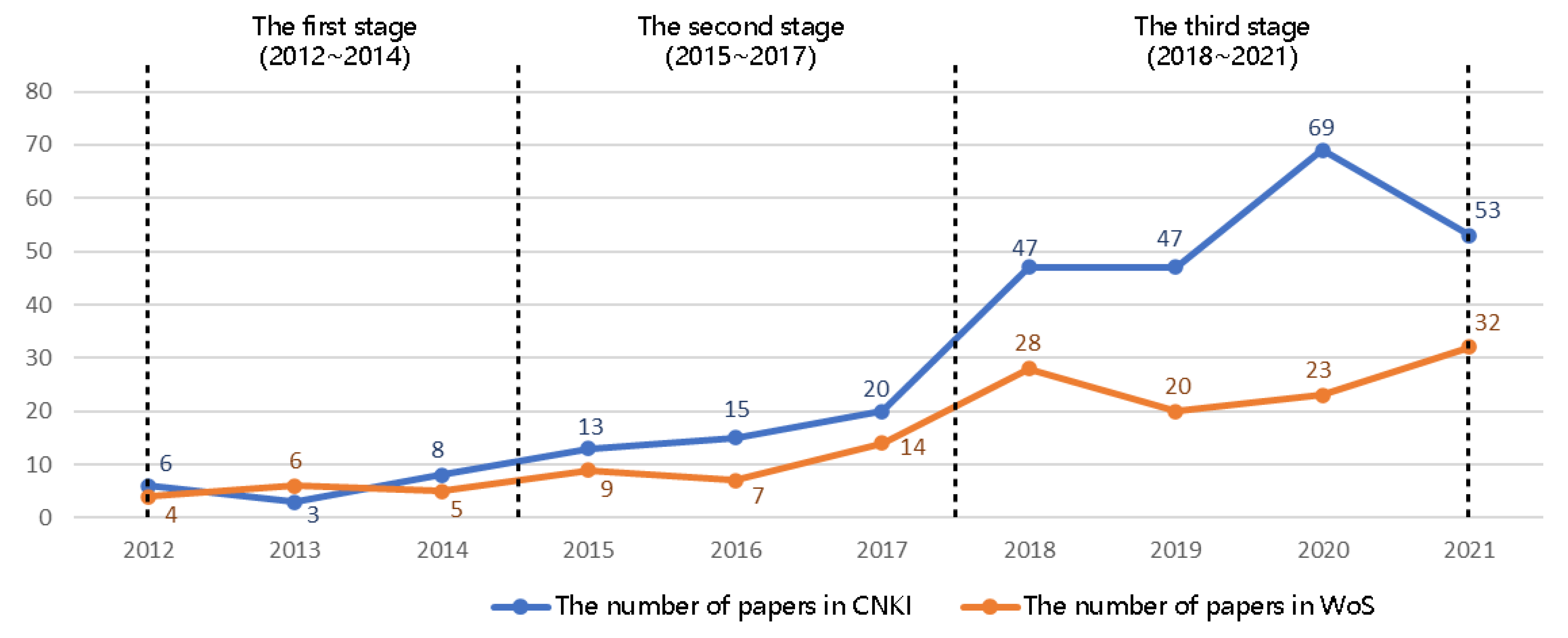
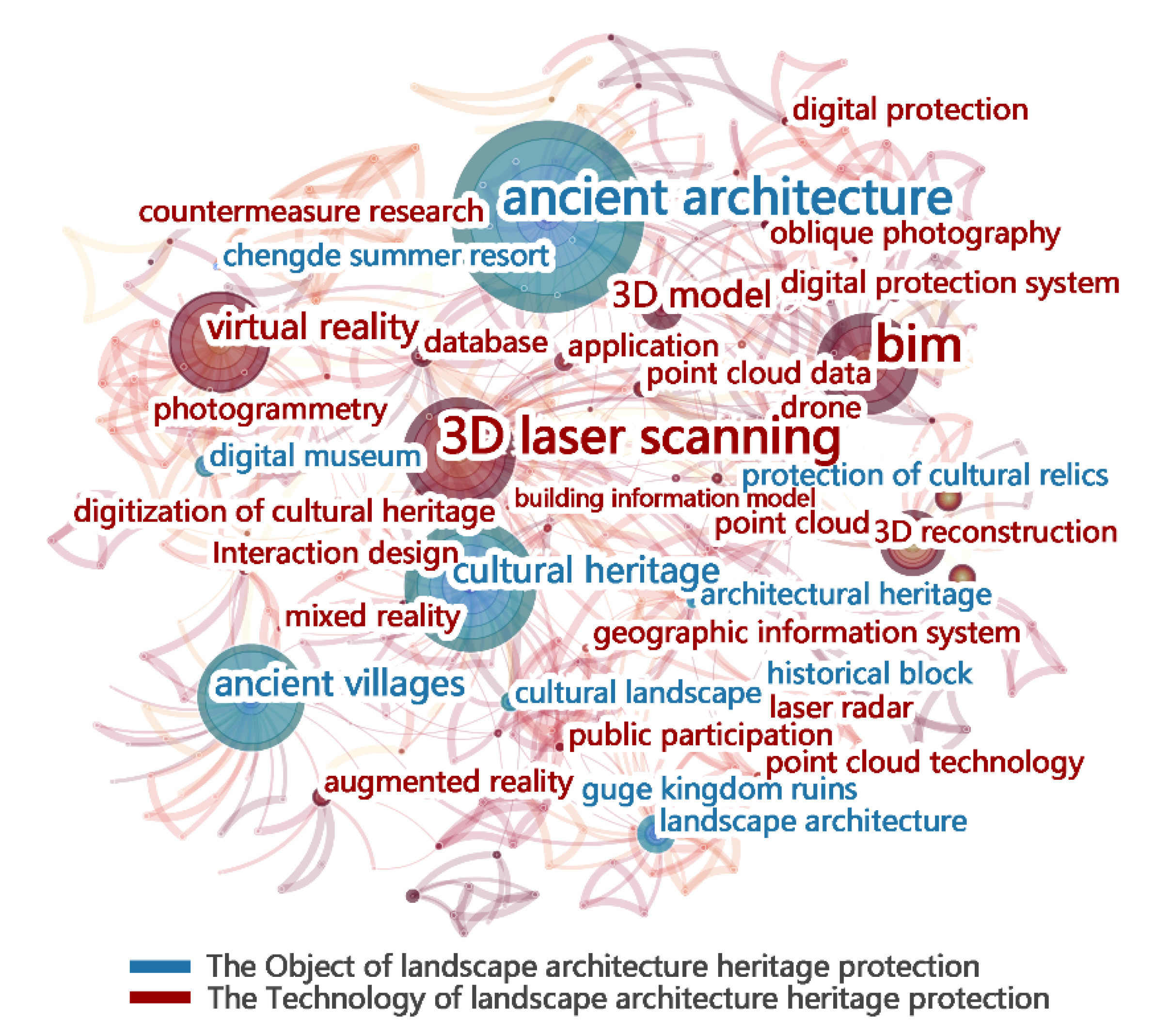
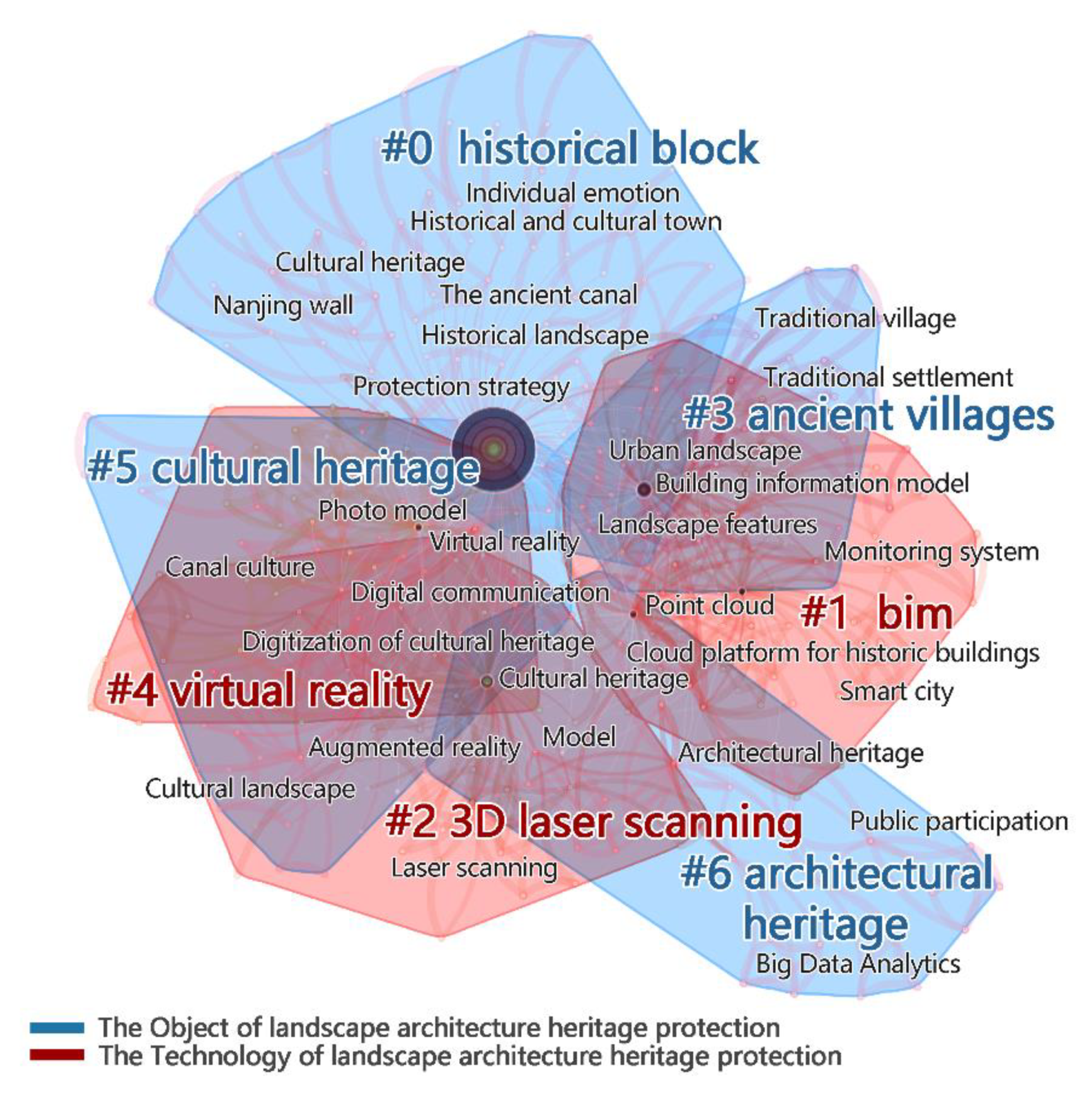

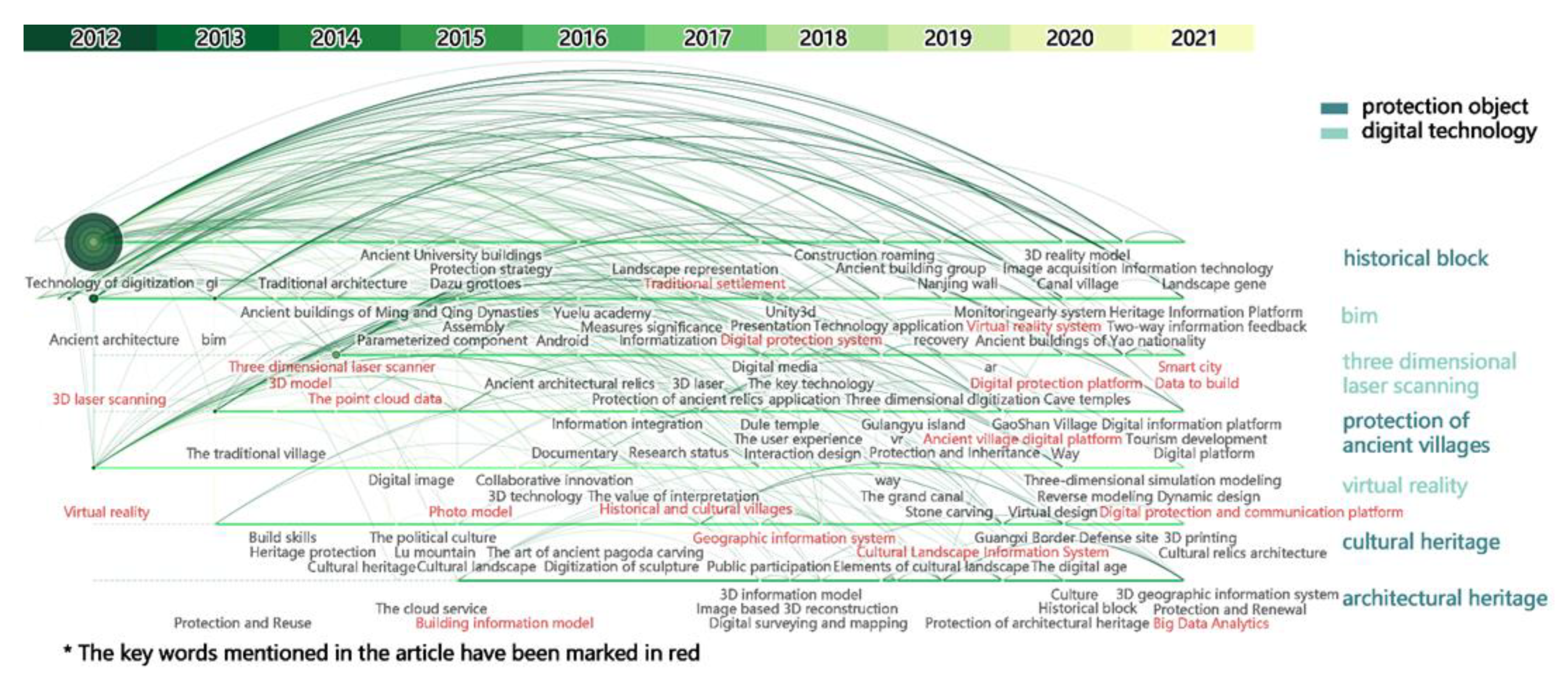
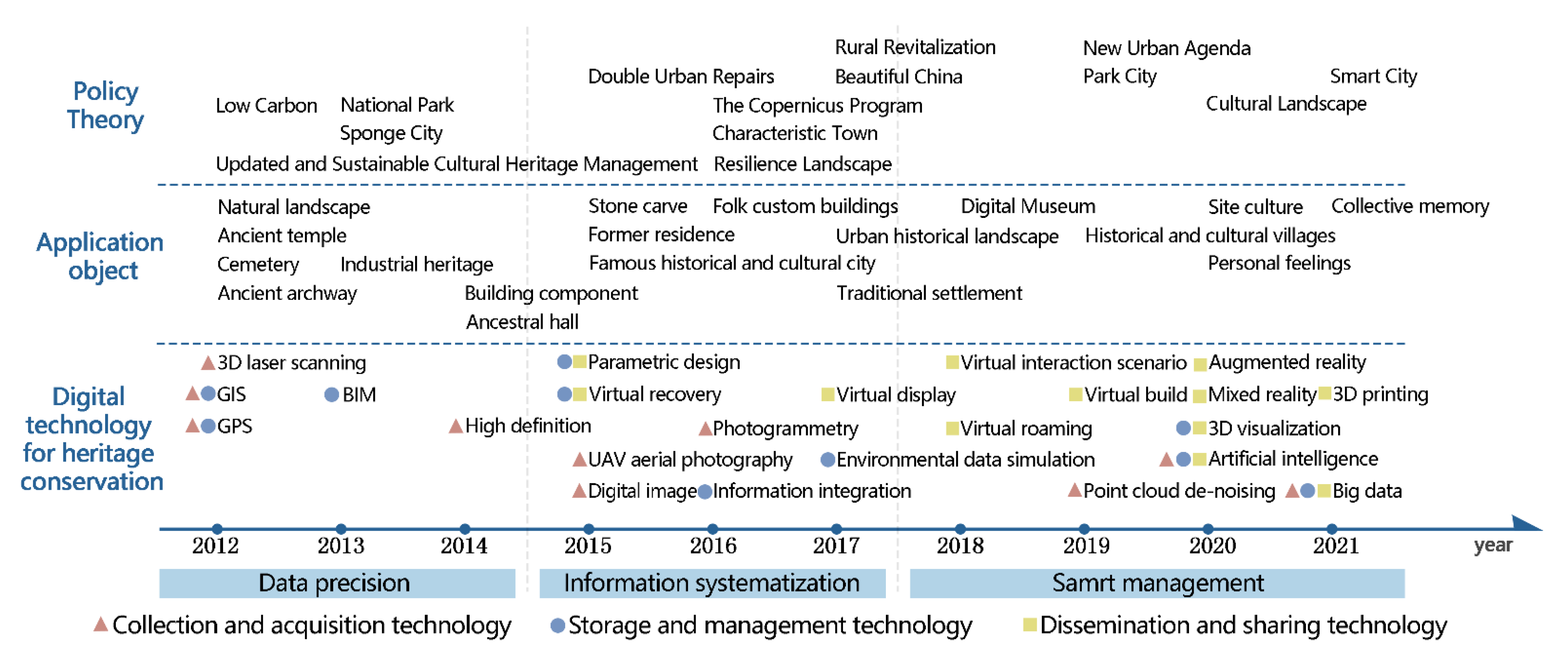
| Clustering | Keywords | Frequency |
|---|---|---|
| Three-dimensional laser scanning | 3D model | 32 |
| Digital protection technology | 25 | |
| Three-dimensional digitization | 23 | |
| Ancient buildings | 18 | |
| Point cloud | 17 | |
| UAV oblique photography | 17 | |
| The point cloud data | 12 | |
| Fine measurement | 6 | |
| Feature extraction | 3 | |
| Protection of surveying and mapping | 2 | |
| Pool and mountain outline | 2 | |
| BIM | Digital protection system | 22 |
| Informatization | 17 | |
| Building protection | 14 | |
| Cloud platform for historic buildings | 13 | |
| Recovery | 12 | |
| Digital information platform | 12 | |
| Parameterized component | 9 | |
| Information expression | 7 | |
| Point cloud denoising processing | 6 | |
| Accuracy of the check | 6 | |
| Simulation analysis | 4 | |
| Forward and reverse modeling | 2 | |
| Virtual reality | Digitization of cultural heritage | 12 |
| Three-dimensional technology | 8 | |
| VR images | 6 | |
| Digital Museum | 6 | |
| Virtual interactive scene design | 5 | |
| Augmented reality | 4 | |
| Construction roaming | 2 | |
| Immersive roaming | 1 |
| The Application Object | The Main Content | Digital Technology |
|---|---|---|
| Topography | Large terrain | Topographic lithologic maps, satellite images |
| Height changes terrain | Ground laser scanning, motion recovery structure data, digital elevation model | |
| Complex landform | Optical remote sensing, deep learning, digital elevation model | |
| The polar landscape | Lidar, remote sensing images, digital elevation models | |
| Rockery | Rockery, rock sketch | Three-dimensional laser scanning |
| Architecture | Texture of building material | Scanning electron microscopy, ultrasonic pulses, computational modeling |
| Architectural features | Point cloud components | |
| Special form | UAV oblique photography, three-dimensional laser scanning, artificial intelligence | |
| Murals, stone carvings | Remote sensing measurement, photogrammetry, three-dimensional reconstruction | |
| Other types | Large area ruins | Big data |
| Historical roads, ancient city walls | Digital photogrammetry, high-resolution digital models | |
| Book images, place names | Digital conversion | |
| Unknown site | Airborne laser scanning, machine learning |
| Storage/Management | The Main Content | Digital Technology |
|---|---|---|
| Storage of heritage data | Storage and maintenance | BIM, big data, digital twins |
| Repair data | Sparse model | |
| Thin provisioning storage space | Dense point cloud reconstruction model | |
| Management of heritage data | Heritage information assessment | HBIM, SDI, repository |
| Maintenance management | BIM, visualization platform | |
| Preventive maintenance | Artificial intelligence |
| Application Direction | The Main Content | Digital Technology |
|---|---|---|
| Repair recovery | Terrain | Digital terrain model |
| Architecture | Three-dimensional laser scanning, BIM, Internet of Things platform, augmented reality, virtual reality, artificial intelligence | |
| Archaeological sites | UAV oblique photography, point cloud, orthophoto, digital surface model | |
| The botanical garden environment | Synthetic aperture radar, terrain synthesis modeling, rendering algorithm | |
| Landscape elements | Digital archives, three-dimensional point cloud technology | |
| Risk monitoring | Assess risk | Interferometric synthetic aperture radar, multi-temporal high-resolution digital elevation model |
| Detect damage factors | BIM, infrared thermal imaging, UAV oblique photography | |
| Statistical damage degree | Remote sensing, GIS, LiDAR | |
| Set up analysis system | Orthophoto, UAV oblique photography, ground laser scanning |
Publisher’s Note: MDPI stays neutral with regard to jurisdictional claims in published maps and institutional affiliations. |
© 2022 by the authors. Licensee MDPI, Basel, Switzerland. This article is an open access article distributed under the terms and conditions of the Creative Commons Attribution (CC BY) license (https://creativecommons.org/licenses/by/4.0/).
Share and Cite
Zhang, R.; Zhang, C. Classification and Application of Digital Technologies in Landscape Heritage Protection. Land 2022, 11, 1699. https://doi.org/10.3390/land11101699
Zhang R, Zhang C. Classification and Application of Digital Technologies in Landscape Heritage Protection. Land. 2022; 11(10):1699. https://doi.org/10.3390/land11101699
Chicago/Turabian StyleZhang, Rui, and Chang Zhang. 2022. "Classification and Application of Digital Technologies in Landscape Heritage Protection" Land 11, no. 10: 1699. https://doi.org/10.3390/land11101699
APA StyleZhang, R., & Zhang, C. (2022). Classification and Application of Digital Technologies in Landscape Heritage Protection. Land, 11(10), 1699. https://doi.org/10.3390/land11101699





